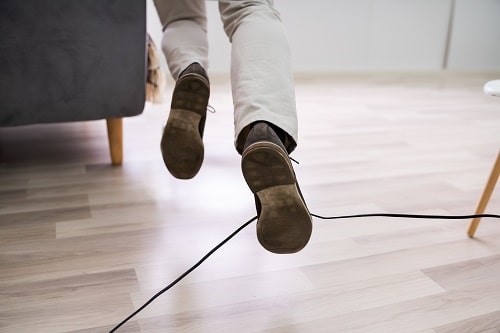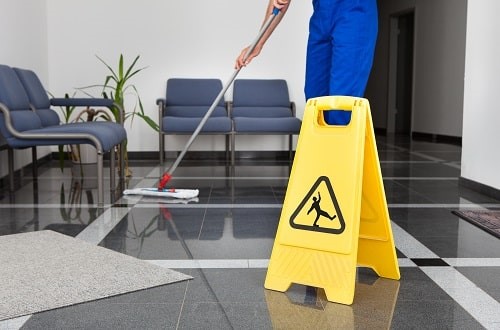Slips, trips and falls are some of the most common causes of injury at work, but there are practical ways of preventing them.
Features
Don’t fall short on slips and trips
Slips, trips and falls are some of the most common causes of injury at work in the UK and globally, accounting for on average 40 per cent of all reported major injuries in UK workplaces alone.
In busy environments with lots of foot traffic, flooring problems can quickly develop into dangerous hazards. From spillages to uneven wear of the floor or the ground surface, it’s crucial that those in control of workplaces and public places take proactive steps to prevent and deal with these issues before they cause a serious problem.
This risk is widespread in UK workplaces, such as factories, warehouses, construction sites, hospitality venues and healthcare establishments. During the period of 2017/18–2019/20, an estimated 971,000 working days were lost to slip, trip and fall injuries in the UK, according to Health and Safety Executive statistics. This equates to an average of 8.5 days lost per case.
 20 per cent of injuries from slips, trips and falls result in employees being off work for three days or more. Photograph: iStock
20 per cent of injuries from slips, trips and falls result in employees being off work for three days or more. Photograph: iStock
Official UK statistics show that, on average, slips, trips and falls on the same level are responsible for:
- Around a third of all non-fatal major (‘specified’) and over-seven-day injuries to employees reported by employers
- Two fatalities per year.
Also, 20 per cent of injuries from slips, trips and falls result in employees being off work for three days or more.
If there’s a risk of staff slipping or tripping at work, which can’t be removed by following the principles of the hierarchy of control (such as by maintaining floors in a safe and non-slip condition and preventing liquid spills), the employer must provide personal protective equipment – such as slip-resistant safety footwear – to help protect employees against the increased risk of accident and injury.
All UK employers have a legal duty to assess risks to the health and safety of workers and others present on their site (such as the public). Where necessary, they must take all reasonably practicable steps to minimise these risks and ensure everyone’s health and safety. This includes assessing – and eliminating or reducing – the risk of workers and others slipping, tripping or falling at work or while visiting the employer’s site or premises.
When assessing the risks, employers should consider the hazards and risks in their workplace that could lead to slip or trip injuries, and then decide on and implement suitable and effective control measures to prevent or reduce the risk of a slip or trip occurring. This might include measures such as:
- Maintaining floor and ground surfaces in good condition so they do not pose a slip or trip hazard
- Providing slip-resistant flooring and matting if the floor is liable to become wet or contaminated
- Ensuring spillages are cleaned up promptly so people do not slip
- Issuing workers with suitable slip-resistant footwear for use in areas where floors and ground surfaces cannot be kept clean and dry.
So, what are some of the most common causes of, and hazards connected to, slips, trips and falls at work, and what should an employer be doing to prevent and mitigate against them?
Slipping hazards
The difficulty with slipping hazards is that there are so many causes. Common causes include fluid leaks from machinery and food production getting onto the floor; rainwater entering a building; and uneven wear of the workplace flooring.
 The law requires employers to ensure that slippery areas do not pose a risk of injury to workers and others, like visitors. Photograph: iStock
The law requires employers to ensure that slippery areas do not pose a risk of injury to workers and others, like visitors. Photograph: iStock
However, employers must remember they have a legal duty under the Workplace (Health, Safety and Welfare) Regulations 1992 to ensure that flooring and pedestrian routes at work are suitable, in good condition and properly maintained so people can move around safely. Floors and traffic routes must also, whenever possible, be kept free from obstructions to reduce the risk of anyone suffering a slip or trip accident or injury.
In short, the law requires employers to take all reasonable steps to ensure that slip and trip hazards like holes, obstacles, uneven areas, slopes and slippery areas do not pose a risk of injury to workers and others, like visitors.
Employers must therefore implement effective measures to reduce the risk of slips, trips and falls – such as ensuring that flooring is regularly and properly maintained, and providing workers with slip-resistant shoes and boots with specially designed soles and tread patterns.
Slip-resistant shoes and boots
Choosing slip-resistant footwear from the array of products on the market can be difficult.
Sole descriptions are varied and, often, footwear is just described as ‘slip resistant’ with no description of the conditions for which the footwear is most suitable.
Also, the selection process will always involve considering other factors – like the level of comfort provided, the footwear’s durability and the need for other safety features, like toe protection. As a result, this means that the final choice often has to be a compromise between these various considerations.
When seeking to select the most appropriate slip-resistant footwear for the conditions at work – and the workers who will be required to wear it – the first step is to carry out a risk assessment to identify the potential slip hazards and risks.
The assessment should identify and consider the type of contaminants that might be present – such as water, oil, chemicals, foodstuffs, dust and condensation.
The employer should also think about how frequently the contamination might occur and the surface or terrain employees will be walking or working on. All these factors will help determine the most suitable type of slip-resistant shoe, boot or trainer for the job.
EN test for slip resistance
Safety footwear must be tested in accordance with the EN ISO 20345 standard and must meet the requirements laid out in this standard.
A slip-resistance test is carried out to measure the slip resistance between the sole of the footwear and the floor. The test can show the slip resistance of a piece of footwear on the surfaces specified in the standard or measure how alternative flooring materials will affect the level of slip resistance offered by the footwear.
For more advice see here
Emma Marrison is Product and procurement manager, footwear at Arco
FEATURES

Why line managers play a vital role in workplace wellbeing
By Marcus Herbert, British Safety Council on 03 September 2023
The behaviours of line managers can have a positive or negative impact on employee health, wellbeing and engagement, so it’s vital managers get staff feedback on whether their management style is supportive or negative, and have regular check-ins so workers can raise concerns about their wellbeing.

Watercooler Event to hone in on eight trends in employee health and wellbeing
By Claire Farrow, Make a Difference Events & Media on 15 April 2024
The free-to-attend Water Cooler Event at ExCeL London on 23–24 April will see more than 6,000 workplace experts coming together to explore the latest thinking, solutions and best practice for supporting and boosting employee wellbeing, diversity and workplace culture.

Sedentary working and how to combat the ‘sitting disease’
By Gavin Bradley, Active Working on 05 April 2024
Prolonged and excessive sitting poses a major risk to our health, but the Get Britain Standing campaign and On Your Feet Britain Day on 25 April are a great way of encouraging workers to sit less and move more.



